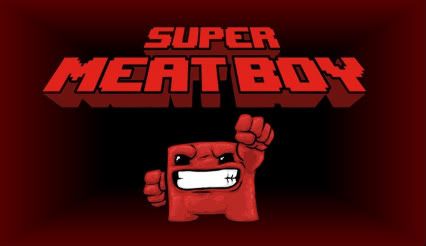 Format: Xbox Live Arcade
Format: Xbox Live ArcadeSuper Meat Boy could easily have been a frustrating, infuriating ball of pain, but instead, it is a frustrating, infuriating ball of pain that is also insanely fun to play.
The game’s premise is simple enough: A classic platformer in which the eponymous Super Meat Boy must save his girlfriend, Bandage Girl, from the clutches of the evil Doctor Fetus. There are dozens of levels to play, each with an even more difficult “dark world” counterpart to unlock, and players compete for the best possible times on each level. Along the way players collect bandages for additional goodies and can unlock warp levels as well. All of these things speak to a platformer lineage to which Super Meat Boy pays homage very effectively.
Immediately upon starting Super Meat Boy, two things are apparent: the levels are incredibly difficult and they each must be completed in a very small time window (usually around five seconds or so). Most levels fit on a single screen and may be outfitted with spinning saw blades, spikes, or other deadly obstacles. The level design is often deceptively simple, even ingeniously so.
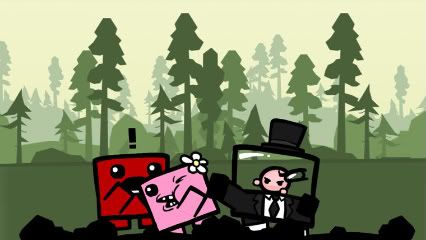
Super Meat Boy, Bandage Girl, and Dr. Fetus. Seriously. Those are their names. No, really...
The most impressive quality of Super Meat Boy is the balance it strikes between difficulty and replay value. The game is insanely difficult. Most often, a level can only be completed effectively by taking a very specific path. Further, achieving the highest ranking (noted by an A+) is only possible by navigating that path in the shortest time possible. Players may rack up more deaths in one level of Super Meat Boy than in any run-of-the-mill shooter. Attempts to retrieve the game’s many hidden bandages, scattered throughout the levels, will almost certainly increase the death count exponentially. And when attempting the dark or warp levels… Well, all but the most seasoned platformer veteran will surely abandon hope.
And yet Super Meat Boy is a joy to play. Most notably, the controls are more precise and reactive than almost any game on the Xbox 360 console to-date. How Team Meat managed to have this little block of bloody protein react so accurately to the Xbox 360 controller is a marvel. And so, when players die – and they will, often – it is painfully evident that it is their own fault.
But death in Super Meat Boy is only temporary. In fact, it is fleeting, if not entirely incidental. Upon death, Meat Boy spawns instantaneously at the level’s beginning, ready to go again. There are no load screens, there are no inquiries as to whether the player wishes to continue. It is as if Meat Boy knows his lot in life is to be turned into a pasty blood puddle by a flying saw blade, and he is happy to do so.
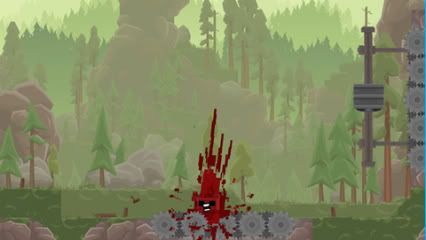
Meat Boy goes "splat." A lot. A WHOLE lot.
There is plenty more to do in Super Meat Boy than simply run and die and occasionally survive. Collectible bandages, unlockable characters, warp levels and dark levels all add an air of exploration and additional challenge to an already jam-packed game. For its sale price of $10, Super Meat Boy is one of the best value for money games on the Xbox Live Marketplace.
Many have commented that perhaps Super Meat Boy is the entirely wrong game for those easily frustrated by difficult video games. But perhaps the opposite is true. If ever there has been a video game that legitimately challenges players and also encourages them to do their very best, it is Super Meat Boy.
]]>
Mike Wilford is CEO of Twisted Pixel Games, the Austin, Texas-based independent developer responsible for cult hits like The Maw, ‘Splosion Man, and most recently Comic Jumper. After graduating from Penn State University in 2001, Wilford spent several years with High-Voltage Software before teaming up to found Twisted Pixel in 2006. Mike was kind enough to spend some time answering a few of our questions about Comic Jumper and what’s in store for Twisted Pixel next…
CG: Comic Jumper has been out for a few days now. Have you been surprised at the reception it received?
Wilford: I am surprised at how strong the reactions are, both positive and negative. We always talk about how we’re just happy if people walk away feeling a strong emotion one way or the other, be it love or hate, and I think with Comic Jumper we have achieved just that. It’s been pretty polarizing. Thankfully, more so in the positive direction than the negative.
CG: Comic Jumper had a relatively long publicity cycle for an XBLA game, starting at PAX 2009. Do you think that as downloadable titles become more popular we’ll see them adopt longer publicity cycles?
Wilford: Yeah just before PAX ’09, on the heels of ‘Splosion Man, people were constantly asking us what we are doing next. We had just completed that promo video (which was originally created solely as a pitch to get Comic Jumper greenlit), so we decided, screw it, let’s toss it out there and get some early reaction and excitement going. I thought it worked out really great for us and anytime you can generate some buzz around a product it is a good thing.
CG: The comic book art styles that you chose for Comic Jumper are not exactly mainstream. How did you arrive at those particular styles?
Wilford: We got together and tossed out a ton of ideas for comic styles we could spoof and pay homage to, but we ended up stripping it down to the four we have in the game now for a number of reasons. We did not want to make this game exclusive to hardcore comic readers and picked what we felt were some pretty recognizable eras to even the most casual fan. We also wanted to make sure that visually each comic was distinct and completely separate from one another. Lastly, it had to be something we could do a lot with in terms of writing.
Little internal fun fact: We actually had a fifth style, which was a Hellboy-inspired horror comic. But due to time constraints we decided we had to cut it.
CG: You’ve stated recently that Twisted Pixel has found a niche in Xbox Live Arcade. What do you think has made Twisted Pixel so successful in that arena?
Wilford: Our focus on “personality” seems to have really hit home with people. We spend a lot of time making sure that the personality of the characters in their design and animation in each game is top notch, and it really has helped make us stand out from the crowd, especially as the production budgets and quality of download games continues to increase.
CG: Writing and audio production really stand out in all of your games, but especially in Comic Jumper. Yet the gameplay is fairly basic—platforming, twin stick shooting, etc. Going forward, do you think that will stay the same? Does Twisted Pixel have any interests in getting into more complicated gameplay?
Wilford: Audio and music for us is extremely important. In many games we have worked on at past companies, sound design and music always felt like an afterthought, and that is just completely wrong to us. Bad sound and music can make the most beautiful art suck or make the simplest visuals feel amazing. Matt “Chainsaw” Chaney, along with our contracted composers Josh Mosley and John DeBorde, do an amazing job and deserve a ton of credit.

CG: Even with the fundamental game mechanics, some people—myself included—have criticized ‘Splosion Man and/or Comic Jumper for being very difficult. Is this by design? Does Twisted Pixel have a guiding philosophy for creating challenging games?
Wilford: We have sadistic game designers in Sean Riley, Sean Conway and Alex Jones. Conway especially loves to make people sad. In all honestly we have to ask him to tone a lot down because believe it or not… he’s pure evil. However, I think today there is a void of old school style games like the ones we all grew up playing in the NES and Genesis eras, and we are trying to channel some of that into our designs. Those old games were way less forgiving with features like no checkpoints, no saves at all, instant one-hit kills, limited lives before you start over from the beginning, and tricks like “You think you beat the game? Sike! Start over from the beginning with twice the difficulty”, to name a few. Even as difficult as ‘Splosion Man or Comic Jumper get, they are still cake in comparison to the classics. And ‘Splosion Man specifically is a great example of how just the right amount of difficulty is extremely rewarding for the player.
CG: Comic Jumper features a ton of great music. Are there any plans to release a soundtrack?
Wilford: All the music is available in the extras of the game itself, but as with ‘Splosion Man, I do believe at some point in the near future all the soundtracks will be posted on our website for free.
CG: I noticed in the credits that a number of musicians are cited in addition to Twisted Pixel’s own Matt Chaney. Where did these contributors come from? Have you considered tapping Austin’s famed music scene for game soundtracks?
Wilford: A lot of the extra music that you hear on the radio in Smiley’s base are bands that people from the company or friends of the company are in. As for the Austin music scene, it is tremendous. But we have built up a really great relationship with the composers John DeBorde and Josh Mosley, who have contributed to our past games, as well as recently hiring Chainsaw full time.
Little internal fun fact: Brina Palencia (Gerda and Paper Lad) and Chris Sabat (the voice of Smiley and Star) created the music for the Manga levels.
CG: Typically, Twisted Pixel has announced their project only a few months after releasing their latest game… (You see where I’m going with this?)
Wilford: We will have something to announce soon.
CG: Can I get an invite to Pancake Thursday?
Wilford: No. But you can come to Money Money Honey Mondays, where we are showered in crisp bills. Ok, its only monopoly money, but if you close your eyes…
]]>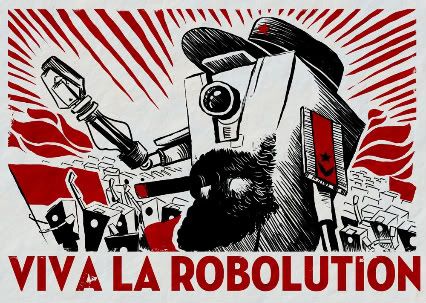
- Format: Xbox 360, PlayStation 3, PC
- Unleashed: Out now
- Publisher: 2K Games
- Developer: Gearbox Software
- Players: 1-4
- Site: http://www.borderlandsthegame.com
It seems impossible for any review of Borderlands DLC not to include the phrase, “If you liked Borderlands…” This is because fans seem only to want more loot, more missions and more guns. For the fourth time, developer Gearbox is delivering with its latest add-on, Claptrap’s New Robot Revolution, and while true fans will certainly be happy at more content, Revolution fails to deliver anything new to the franchise.
Revolution can be easily qualified as “more Borderlands”, which is hardly a bad thing. More than any effort prior, Borderlands successfully combined the loot-focused exploration and character customization of the RPG with the twitch-sensitive action of a modern shooter. It seems that anyone who undertook Borderlands ended up sinking 100+ hours into the title and continued itching for more of Pandora to explore. That is exactly what Revolution provides.

This can't be good.
Those who finished Borderlands will recall a strange cutscene featuring an “interplanetary ninja assassin” Claptrap, a cameo that was never explained. Now, the story is being told. This rogue Claptrap robot is fed up with the enslavement of Claptrap-kind and has raised an army of automated assailants to take over Pandora. Players will navigate a large addition to the planet, fight off Claptrap-inspired assailants, and eventually bring the entire Borderlands title around full-circle.
The core of the story missions are undertaken at the behest of the Hyperion Corporation, continuing Gearbox’s tradition of incorporating a single gun manufacturer into the DLC’s story. The Hyperion Corporation unleashed this Claptrap menace and now they are seeking help with containing it. There seems to be more voice work contained in the NPC dialogue, which is entertaining, and the window on another company’s machinations is kind of neat. Players will get a small peek into Hyperion and probably notice how similar in appearance it is to the Atlas Corporation from the General Knoxx DLC.
In fact, much of the content in Revolution is rehashed from Borderlands and its other DLC offerings. Most enemies are just bandits or soldiers that players will have seen before, tricked out with robotic attachments to provide that “Claptrap feel”. The chapter takes this tongue-in-cheek, pitting players against literal cardboard cutouts of many Borderlands favorites but this doesn’t excuse the obvious repurposing of existing assets, which cannot be ignored.

Tartarus Station is lovely this time of year...
What’s most disappointing however is the seeming lack of any new weaponry inside Revolution. Anyone who has played Borderlands for any length of time knows that the game trades on one major currency: guns. The inclusion of a new gun rarity in The Secret Armory of General Knoxx helped spur sales of that DLC, for certain. Unfortunately, Gearbox failed to learn from that success and instead has just populated Revolution with more average-grade firearms. Even after the DLC’s final mission, when players are treated to a trip inside Hyperion’s private gun locker, the findings are mostly a letdown.
The fact that Revolution exists at all should be appreciated by all Borderlands players. In a recent interview, Gearbox head Randy Pitchford admitted that the team never intended to create four DLC packs for Borderlands. But when fans asked for more, Gearbox could not refuse. So it’s entirely possible that Revolution may not be the last Borderlands DLC.
But all gratefulness aside, Revolution will stand as one of the least successful DLC packs for Borderlands, due to its lack of new items and unfortunate recycling of existing assets. Yes, it is more of what players want, but it is not more of what fans deserve.
6/10
]]>
- Format: Xbox 360 (XBLA)
- Unleashed: October 6
- Publisher: Twisted Pixel Games, Microsoft Game Studio
- Developer: Twisted Pixel Games
- Players: 1
- Site: http://www.twistedpixelgames.com
With its first two releases, developer Twisted Pixel has carved out a unique niche for itself as the creator of games that are as entertaining as they are challenging. Their latest release, Comic Jumper, sticks to that model, but also offers players a smorgasbord of additional content, making this XBLA title great value.
Players take on the role of Captain Smiley, a modern day action comic hero who finds himself without a publication. So he—along with his sidekick, Star, who is actually stuck to the Captain’s chest—are relegated to the pages of other comics, where they serve as stand-ins, hoping to make enough money to one day buy their own title. This premise allows for one of the most intriguing elements of Comic Jumper: the game’s various comic book-inspired design themes. Throughout the game, players will enter a Conan the Barbarian-inspired comic, a Japanese manga title, and a classic-era science fiction comic. Each of these has been created with expert hands and is delivered with a unique suite of art and music assets that are immersive yet distinct.
The variety and attention to detail within each of these unique comic environments might have been sufficient enough to carry Comic Jumper. But Twisted Pixel was obviously not content to simply suffice. Instead, they created a base of operations for Captain and Star that players can explore in between missions. Here players can interact with characters from the game, view their stats and leaderboards (fast becoming a hallmark of Twisted Pixel titles), and even demo or purchase other Twisted Pixel titles. The base also serves as a place for the Captain to upgrade his abilities and unlock collectibles like developer interviews and avatar items. All of these goodies provide significant replay value. But what’s more, they demonstrate Twisted Pixel’s increasing skill at making their players feel like part of something more than just a video game. The inside jokes and self-referential breaking of the fourth wall that permeate Comic Jumper create both an “indie vibe” as well as a window—as ridiculous as it may be—into the minds of the developers themselves. It’s reminiscent of Monty Python’s Flying Circus, and there is no doubt Twisted Pixel will soon have a similar cult following behind them as a result.
This is not to suggest that production value is the only stand-out in Comic Jumper. The gameplay is also a good deal of fun, if at times a little trying. Comic Jumper is predominantly a side-scrolling action shooter and platformer. However, Twisted Pixel has created as much an homage to games as to comics by incorporating mechanics from the likes of Galaga, Asteroids, and other arcade classics. It helps to break up what could be some very monotonous run-and-shoot gameplay. Even changing the scroll direction to be right-to-left in the manga section is a neat touch.
It bears comment, however, that Comic Jumper occasionally features some severe difficulty spikes. This was a trait of Twisted Pixel’s last title, ‘Splosion Man, as well. At that time, it could be thought that the occasional increases in difficulty were design errors or, at the best, coincidence. But there is no doubt Twisted Pixel meant for Comic Jumper to cater to the hardcore gaming crowd by making the game sometimes excruciatingly difficult but then encouraging competition and persistence through the inclusion of leaderboards.
But players will continue to return to Comic Jumper, either out of love or addiction or hard-headedness. Regardless of the reason, Comic Jumper will continue to provide value for a very long time. And when players have had their fill, they will be looking very forward to Twisted Pixel’s next offering.
8/10
]]>
- Format: PC
- Unleashed: Out now
- Publisher: Hi-Rez Studios
- Developer: Hi-Rez Studios
- Players:
- Site: http://www.globalagendagame.com
In early July, the developer Realtime Worlds released its anarchical crime-based shooter MMO, APB: All Points Bulletin. After only three months and following Realtime Worlds’ significant financial woes, APB was shut down entirely. Seemingly, the persistent whispers that no studio could successfully combine the shooter and MMO genres seemed to be validated once again.
Enter Hi-Rez Studios and their shooter MMO, Global Agenda.
Released in February, Global Agenda is a third-person science fiction shooter and MMO that combines the class and team-based combat of a modern shooter with the character customisation and player interaction of a massively multiplayer online game. It is not fee-based, but rather only requires the game’s initial purchase without any further subscriptions. What’s more, Global Agenda took the opportunity of APB’s downfall to offer discounted entry to that game’s understandably frustrated players.
Global Agenda is set in the not-too-distant future, when a “Big Brother” government known as The Commonwealth lords over the planet and generally causes everyone significant grief. Choosing one of the four classes—Assault, Medic, Recon, or Robotics—the player is constantly pitted against various baddies and placed in missions that benefit greatly from a team-based approach. An expansion to Global Agenda, titled Sandstorm, was released several months ago and added weapons, loot, missions, and areas to the game world.
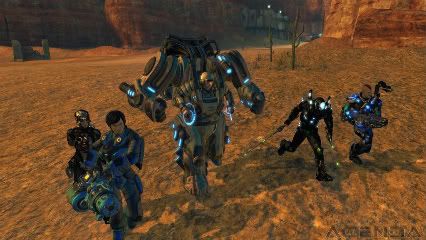
"You guys wanna get a smoothie after this?"
The pitfall that other shooter MMOs run into, it seems, is meeting the expectations of both shooter fans and MMO fans alike. Players of modern shooters have come to expect rapid combat, twitch-sensitive controls, and unparalleled precision from their game experiences. Fans of MMOs, however, tend to favor a broader scope that encourages exploration and deep character interaction. The best complement one can give Global Agenda is that it does all of these things competently.
Global Agenda is a good third-person shooter. The controls are tight and precise. The weapons have their own character and physics. And there is enough innovation in the player customisation options to keep shooter fans interested and coming back for more. Aside from typical equipment upgrades like better guns and armour, players can purchase dyes to customise certain parts of their character’s avatar. And, depending on which class a player chooses, there are some very interesting class-based perks available. The Robotic is a powerful, tactically advantageous class that can provide shields to teammates or build turrets on the battlefield. Medics can obviously support their team through healing abilities, while the Assault class is sufficiently badass with guns large and small. Perhaps most intriguing, however, is the Recon class. Hi-Rez has taken two traditional shooter classes—the long-range sniper and the melee-focused stealth—and combined them in the Recon class. While the description may suggest a confusing, unfocused character type, the player who learns to use Recon properly can be devastating against AI-controlled opponents and real players alike.
Global Agenda can be played in a variety of ways, but it is most rewarding when played with a group. The PvE (player-versus-environment) missions are perhaps the most enjoyable. They are easy to enter, clearly defined, and offer the best opportunity to meet new players—which, if you’re going to get deep into Global Agenda, is advisable. Teams of four navigate short PvE maps to ultimately challenge a final boss, who often can only be effectively eliminated if the team works together. This is essential. Perhaps more than any class-based shooter, Global Agenda absolutely requires that every player knows and carries out their role. This can cause the game to seem daunting to first-timers. But after several hours of PvE challenges and getting accustomed to the classes, Global Agenda’s PvE mode becomes a ton of fun. (It should be mentioned that, for an MMO—or online game of any kind, really—Global Agenda has developed an incredibly welcoming community of players. Any concerns about “noobishness” or inexperience should be left at the door. Help can almost always be found in the form of other players, and makes the experience that much more rewarding.)
While PvE is a good place to start the cooperative experience of Global Agenda, the PvP portion is where things get intense. These games involve larger areas with objective-based missions and teams of real players slugging it out for victory. If a player does not know what they’re doing in Global Agenda, PvP might not be for them. At times it can be intense, and victory is often reliant upon each team member understanding their objective and supporting the team to achieve it.
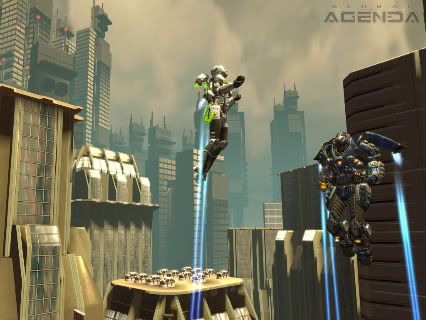
Jetpacks!
If this is not enough value for the seasoned shooter veteran or MMO grinder, Global Agenda offers a persistent global domination mode known as Conquest for an additional subscription fee. In Conquest, players may join an Alliance and combat other similar organisations for control of areas in the game world. In addition to the typical combat, there are coups to be carried out and accords to be made with other teams in order to secure one Alliance’s domination over others. Conquest is a deep and extensive offering, and it’s obvious that Global Agenda’s most committed devotees could spend a lot of time in that game mode alone.
While the shooting is tight and the gameplay options are rewarding in their variety, Global Agenda suffers from a lacklustre presentation. The game world consists of brown, grey, brownish grey, and greyish brown. This would be forgivable in a game with greater attention to detail. Unfortunately, Global Agenda is not such a game. What’s more, the open world that is available for exploration is quite large—a bonus, to be sure. But when considering the lack of texture or definition, just getting around can be boring. The sound design is similarly sparse and does little to help immerse players in the game world.
Global Agenda is a good shooter and a good MMO with a great opportunity at its feet. With improved presentation, it could be great. Only time will tell if Global Agenda will suffer the same fate as its shooter MMO predecessors or be the exception to the rule.
8/10
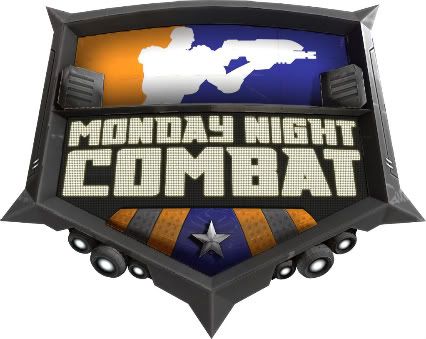
- Format: XBLA
- Unleashed: Out now
- Publisher: Uber Entertainment, Inc.
- Developer: Uber Entertainment, Inc.
- Players: 1-12
- Site: http://www.uberent.com/
Xbox Live’s “Summer of Arcade” is a grab bag. There is some good and bad. And there is always at least one surprise hit. This summer, it seems, that honour can be awarded to Monday Night Combat.
From Uber Entertainment, Monday Night Combat combines two fan-favourite genres: third-person class-based shooters and tower defense games. The game is set in a quirky arena-style world fashioned after professional sports leagues. There are goofy brand-name sponsors, mascots who toss money, and an extremely busty support mechanic known as the “pit girl.” The humour is enjoyable—if simple.
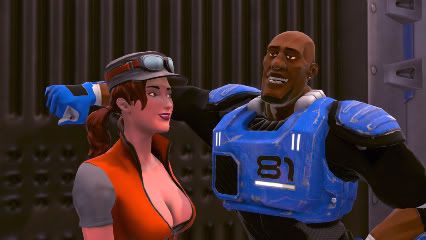
The Assault puts the moves on Pit Girl...
A saving grace of MNC is that it is a tight, concise product. The concept could have easily been diluted and muddied by too many game types, too many classes, and more. But the content is executed well and makes for some very fun gaming. For 1200 MS points, there is a lot of value in what is presented.
There are two game types: Blitz and Crossfire. Both fundamentally revolve around protecting your team’s “moneyball.” In Blitz, a team of up to four players must defend the moneyball against an increasingly numerous and powerful army of AI-controlled robots. If Gears of War Horde mode or the Firefight mode of Halo 3: ODST got you excited, then Blitz is probably for you. Crossfire is the online multiplayer component. Two teams of six face off, attempting to simultaneously protect their moneyball and destroy the opposing team’s moneyball. The interesting feature of Crossfire is that the moneyball’s shields cannot be penetrated by the human players. For that, they must rely upon their team’s AI-controlled robot troops, which players can guide and protect. This is the key to winning MNC: protect your team’s robots and help them take down the other team’s moneyball. This one gameplay feature is what makes the online MNC experience truly unique and quells all of those early (and presumptuous) comparisons to Team Fortress 2.
Those comparisons were probably knee-jerk reactions to MNC’s stock character classes. There are six, and most are familiar to seasoned gamers: the assault, the gunner, the support, etc. Each has four abilities that they can upgrade mid-combat by earning money. One or any combination of these classes can conquer the easier levels of Blitz mode. But in the harder Blitz levels and in Crossfire, players must know and carry out their role. Uber Entertainment has done a good job balancing the classes so that they play according to their abilities and weaknesses. The assassin cannot simply hang back and play defense. Nor can the sniper rush into the opponent’s base with guns blazing.
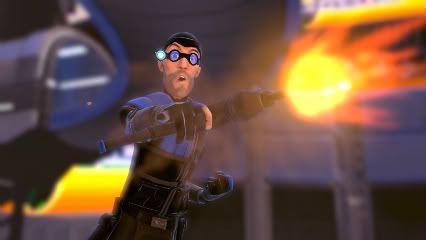
Ill-advised: The Sniper rushing with an uzi.
MNC provides the opportunity to create a custom class, but this happens to be the game’s main failing. For one, it takes a while to unlock the first custom class slot. Doing so costs $15,000, and that money doesn’t come easily – and the customisation options are sparse. Players may choose one of the six stock classes, then assign that class three different buffers—stronger armour, better speed, more ammo, etc. That’s it. Granted, the potential combinations are interesting. An assassin (fast but frail) with enhanced armor and greater health could be a significant threat. But these days multiplayer customisation requires more.
MNC manages to deliver a great deal of fun and value with a unique spin on some old genres. Of the games offered in “Summer of Arcade,” it may have the most replay value. And if Uber provides it the right support, they could have a long-term success on their hands.
4/5
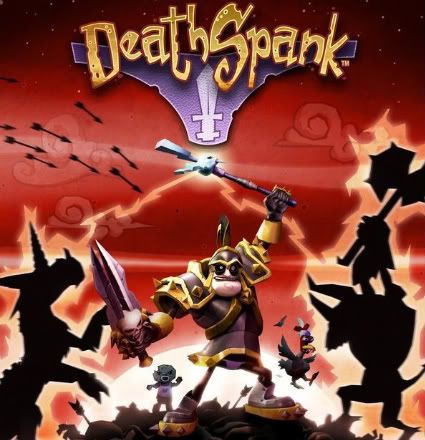
- Format: XBLA (version reviewed), PSN
- Unleashed: Out now
- Publisher: Electronic Arts
- Developer: Hothead Games
- Players: 1
- Site: www.deathspank.com
DeathSpank is a game that was made with love. Games in this category are few and far between, but they are easily spotted: unique art styles, tight characterisation, self-aware sense of humour. Most importantly, games in this category give the sense that they would have been made no matter what. And it’s a good thing, because such games also tend to break up a monotonous game market. Think Team Fortress 2. Think Borderlands.
And now, think DeathSpank.
Ron Gilbert, the creative mind behind classic adventure games like Maniac Mansion and the Monkey Island series, conceived of DeathSpank years ago. And while Gilbert has since left developer Hothead Games, DeathSpank still manages to deliver its originator’s unique take on design and humour. Immediately noticeable is DeathSpank’s graphic style. Call it cartoony, with a kind of cel-shading and a world that rolls (rather than scrolls) with the character’s movements, as if it was all drawn on a giant tube. DeathSpank himself is an overly confident justice addict obsessed with helping the downtrodden but also disturbingly suspicious of others, like orphans. The characterisation of DeathSpank and the world’s other inhabitants is delivered clearly through an impressive array of dialogue options. Unfortunately, much of the humour is plain and predictable. But the amount of work put into the dialogue and voice work is respectable. Again, the attention to detail demonstrates the creators’ affection for the game. DeathSpank combines the best elements of adventure games and hack-and-slash RPGs, including dungeon-crawling, plenty of loot, and leveling up. There are new, humorously named weapons to pick up at nearly every turn. These are mapped directly to the controller’s four face buttons, so it’s simply a matter of mashing away to vanquish evil. One smart move—and hopefully something other developers will learn from—is the Grinder. You know those useless items taking up your inventory slots? Just toss ‘em in the Grinder and they instantly turn into cold, hard cash.
DeathSpank combines the best elements of adventure games and hack-and-slash RPGs, including dungeon-crawling, plenty of loot, and leveling up. There are new, humorously named weapons to pick up at nearly every turn. These are mapped directly to the controller’s four face buttons, so it’s simply a matter of mashing away to vanquish evil. One smart move—and hopefully something other developers will learn from—is the Grinder. You know those useless items taking up your inventory slots? Just toss ‘em in the Grinder and they instantly turn into cold, hard cash.
Another of the game’s valuable traits is accessibility. The rolling world is seamless; there is no loading necessary as players make their way through the game. Saving and fast travel is made possible through an array of…outhouses. (Funny, right?)
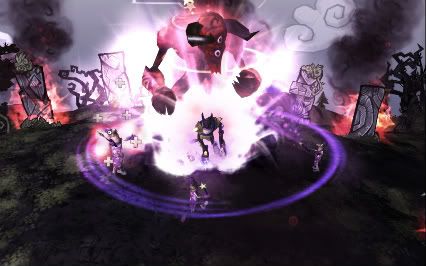 The co-op system, while not entirely robust, makes the game a lot of fun to play with kids or less experienced gamers. As DeathSpank is controlled by the first player, a co-op partner can join in as Sparkles, a mage who plays a support role. Sparkles can heal and provide other benefits, but he cannot level up or take advantage of all of the game’s benefits as can DeathSpank. Calling DeathSpank a “two-player game” might be a stretch. It is more like a “1.5 player game.”
The co-op system, while not entirely robust, makes the game a lot of fun to play with kids or less experienced gamers. As DeathSpank is controlled by the first player, a co-op partner can join in as Sparkles, a mage who plays a support role. Sparkles can heal and provide other benefits, but he cannot level up or take advantage of all of the game’s benefits as can DeathSpank. Calling DeathSpank a “two-player game” might be a stretch. It is more like a “1.5 player game.”
The amount of quests, loot, and dialogue in DeathSpank ensure its value to anyone who appreciates a good hack-and-slash dungeon crawler. While some of the humour is obviously contrived and falls flat, there is no denying that Ron Gilbert and the game’s other designers put their all into DeathSpank.
4/5
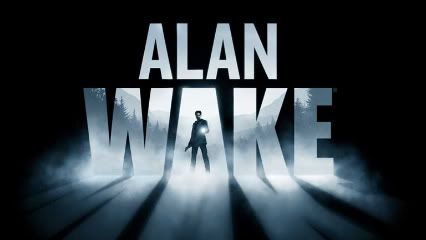
- Format: Xbox 360
- Unleashed: Out now
- Publisher: Microsoft Game Studios
- Developer: Remedy Entertainment
- Players: 1
- Site: www.alanwake.com
The first DLC chapter for Remedy’s suspense-horror hit Alan Wake has arrived. This next chapter, titled “The Signal,” delivers more of what made the full game so successful, but in a much tighter package. The Signal is free for those who bought Alan Wake new, and 560 MS points for everyone else.
The Signal picks up immediately where the full game left off—with the author trapped in a nightmare of his own making. Players will encounter fan-favorite Barry, as well as enigmatic author and diving suit aficionado Thomas Zane.

More Barry can only be a good thing.
The best compliment one can offer The Signal is that it delivers more of the same—more beautiful flashlight mechanics, more ammo hoarding, more dark suspense… Alan Wake was a terrific game, and in lieu of a full-sized sequel, any expansion that carries on the game’s design, style, and gameplay is a great addition. The Signal will take players through some of the same sets from the game, including the diner and the spooky forest from the first couple of chapters. For the completionists, The Signal offers two new sets of collectibles: alarm clocks and cardboard standees. And the related achievements ensure that The Signal will get at least two playthroughs, and that’s for the highly skilled player. So anyone who loved and cherished Alan Wake will find just as much to enjoy in The Signal.
This new chapter also reveals some new interactive elements that make for an interesting challenge. In particular, Wake’s flashlight now becomes the harbinger of enemies. If the flashlight beam is pointed in the wrong spot, players could find themselves surrounded by dozens of Taken. And for anyone who has played the game on the Hard or Nightmare difficulty, such a concept is spine-chilling in its own right. Remedy’s design of this particular area and the concept of making light—Wake’s only safe haven in the full game—become the enemy is brilliant.
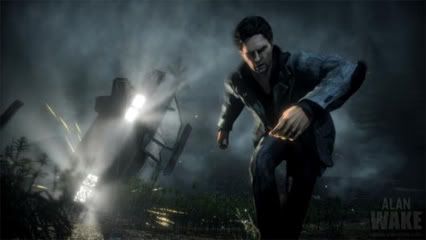
There will be cars. And they will fly through the air.
While true fans of Alan Wake will find more than enough to make them squeal with glee and shriek in fear, there are still two very substantial problems with The Signal that could make that 560-point price tag seem high: The Signal is very difficult, and it is very brief. Early in the chapter, a large cache of ammo and supplies is dumped at the player’s feet, rightly suggesting that there will be many enemies to contend with. And there are. It is very easy to get surrounded or hit from behind, which was one of the few frustrating elements of the full game. So regardless of the abundant ammo, The Signal almost encourages one to sprint from light source to light source in the interests of survival. This turns out to be the most effective strategy. The unfortunate consequence is that The Signal turns out to be very brief—no matter to those who get it for free, but perhaps a point of contention for paying customers.
What’s more, there is no real narrative extension here. The Signal opens with Alan Wake being trapped in “the dark place,” battling insanity. And, without spoiling the chapter, things are not very different at the end. The final boss battle, too, might prove disappointing for anyone who was let down by the full game’s last encounter.
As a free piece of DLC or as a paid download for hardcore fans, The Signal is a great addition to Alan Wake. But casual players might reconsider, especially if the first game did not offer them much enjoyment.
3/5


